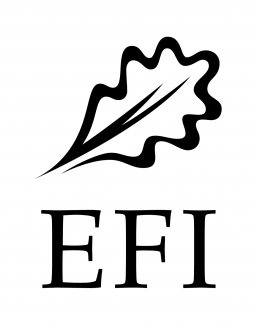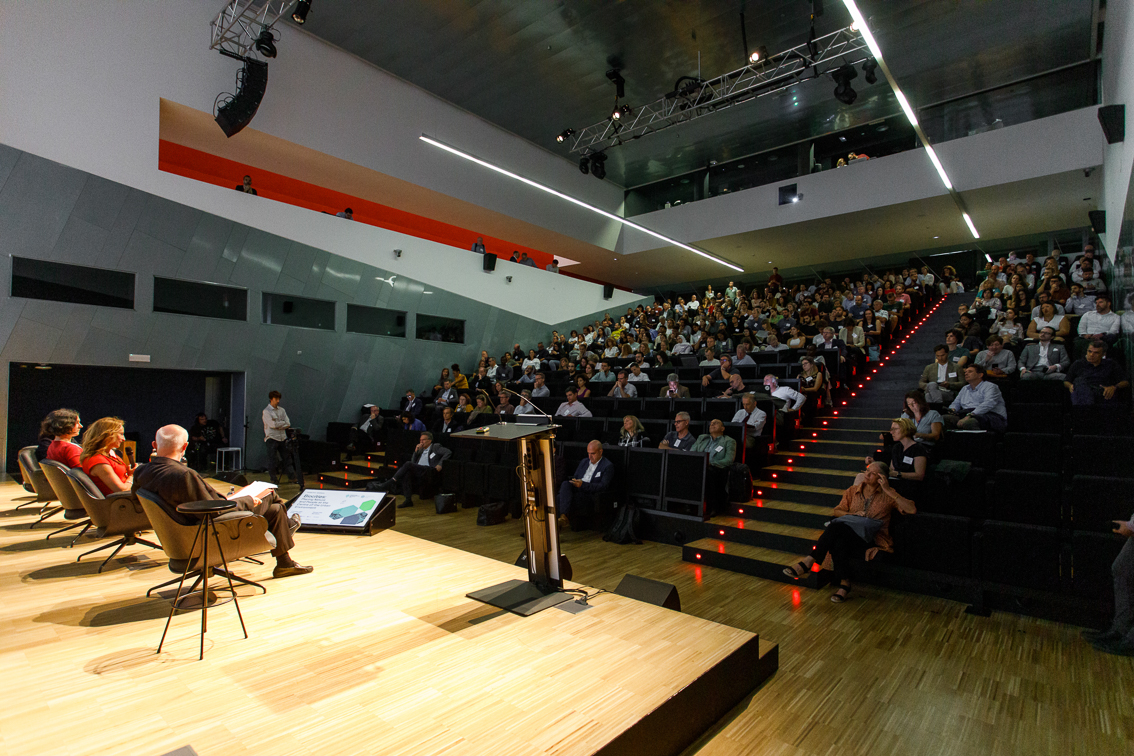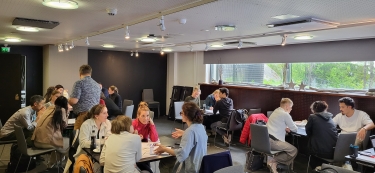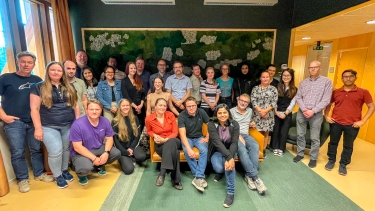Biocities: placing nature and people at the centre of the urban environment

EFI’s 2022 Scientific Seminar on 6 October shattered any notion of a forest research silo with a cross-sectoral exploration of the transformative potential of trees, forests and wood to rethink the built environment. “Biocities: placing nature and people at the centre of the urban environment” placed architects, health workers, urban planners, policymakers and civil society representatives alongside forest scientists, managers and practitioners to discuss how we might create healthy, sustainable and resilient cities as well as rural-urban sustainable interfaces.
The seminar was organised together with our member organisations the Institute for Advanced Architecture of Catalonia, Forest Sciences Center of Catalonia, CREAF – Centre for Ecological Research and Forestry Applications, as well as Àrea Metropolitana de Barcelona, Diputación Provincial de Barcelona, Ajuntament de Barcelona, Generalitat de Catalunya, Parc de Belloch SL and 1t.org.
EFI Director Marc Palahí opened the meeting with a welcome address before presenting Barcelona’s deputy Mayor, Janet Sanz, with the 2022 European Forest City award. Prof. Dr. John Schellnhuber (Director Emeritus of the Potsdam Institute for Climate Impact Research, Founder and Managing Director of Bauhaus Earth) gave the keynote speech, challenging the audience to consider how we could make the construction sector a hero in the fight against climate change, before illustrating the possibilities for timber construction for the built environment and dreaming of a new dawn of a cyberorganic age.
Prof. Dr. Schellnhuber then moderated a panel presentation and discussion session which offered a science perspective on the nature of cities and how nature can transform them. Three researchers from different sectors shared insights from health, urban ecosystem sciences, and architecture.
Matilda van den Bosch (Barcelona Institute for Global Health) considered how nature can improve human health in urban areas. She shared studies showing that health care systems spend less per person per year on medical care for people living in areas with more green space, and described clear links between ADHD and depression with air pollution and lack of green space.
Galina Churkina (Urban Ecosystem Sciences, Technical University of Berlin) also challenged a commonly held viewpoint, asking the audience to consider cities as carbon sinks. Instead of major emitters of carbon, she presented cities as complex systems, with many positive aspects. What if buildings could store carbon in the wood and other materials they use, as well as producing low emissions, with indoor temperatures remaining constant despite no heating or cooling?
Barbara Widera (Wroclaw University of Science and Technology, Faculty of Architecture) presented various nature-based solutions for climate resilient buildings and cities, ranging from adapting a building’s position in relation to the sun, shading strategies, evaporative cooling, flows and mobility and striving for symbiosis where cities can coexist with nature.
Indeed, creating cities in symbiosis with nature was the theme for the following two panel sessions. Vicente Guallart (Director, Guallart Architects) gave a keynote on transforming our cities into Biocities, where cities follow the rules of natural systems to promote life and biodiversity. He shared the Barcelona Protocol, a European Action Plan for the City and the Earth, signed two days’ previously at a cocktail reception at the Mass is More installation at the Mies van der Rohe pavilion, and called on cities to sign up!
The first panel, Biobased construction for regenerative urbanization, was moderated by Andreja Kutnar (InnoRenew, Slovenia). Devothe Mukeshimana (Rwanda) described various bio-based building materials in addition to wood which are used effectively in Rwanda, including bamboo, straw, reeds, hemp, flax and mycelium (a compostable natural fungi material). Tye Farrow (Farrow Partners Architects, Canada) asked the audience to consider the impact if health was the basis on which every public building was judged, and whether our built environments are health giving or eroding our ability to flourish, before describing a beautiful, multi-functional and enriching saluto-systemic approach to the Venice archipelago. Alan Organschi (Gray Organschi architecture & Bauhaus Earth) called on architects to go into the forest, and stated that bringing trees and biodiversity into our cities is not enough to create a Biocity. We need to think of green infrastructure and long-term rewards, and the relationship between the city and the whole Bioregion that surrounds it.
The second panel on urban ecology and forest trees was moderated by Cecil Konijnendijk (Director, Nature Based Solutions Institute) and discussions began by panellists considering how we might ensure people and nature stay connected. It is vital that users have access to nature on their daily routes but bringing together a consortium of people for cross-sectoral collaboration is fundamental to success for urban greening. While political cycles may be transitory, funding is needed with long-term vision. Tree-planting programmes must be underpinned by proper long-term maintenance and management, and that is often where funds fall short. Engaging with the local population can drive a longer-term perspective and encourage local communities to demand support. Panellists were Andrej Verlic (Head of Nature Conservation Unit, JP Voka Snaga), Wiebke Klemm (Senior Policy Advisor, Municipality of The Hague), Maria Chiara Pastore (Stefano Boeri Architetti), Yvonne Lynch (Royal Commission for Riyadh City on Green Riyadh) and Fredéric Segur (Urban Forest Management, City of Lyon).
The final session of the day looked into initiatives building synergies and bringing knowledge to action, and was moderated by Carla Conejo González (Science Academy, Fundacio Catalunya La Pedrera). Giuseppe Scarascia-Mugnozza unveiled EFI’s newest Facility, the EFI Biocities Facility, which aims to create an informed dialogue on how trees, forests and wood can contribute to rethinking our cities. Amanda Sturgeon presented Built by Nature, a network and grant-making fund dedicated to accelerating the timber building transformation in Europe. Marina Ruta described the concept of BiodiverCities, where urban centres become hubs for innovation, cooperation, inspiration and economic growth, and have the potential to help protect biodiversity. Franziska Schreiber explained the Bauhaus der Erde mission to transform the way we construct and maintain the built environment so that the human species may live in dignity and harmony with the Earth’s natural systems. Rik De Vreese called on the audience to join the Uforest Alliance which unites enterprises, practitioners, decision-makers, agencies and researchers working on urban forest items, offering networking, innovation, knowledge exchange and training opportunities.
The panel collectively considered that no one approach makes a Biocity and that multi-faceted facilitation and community engagement, across sectors and scales, is needed. Communication, education, and interdisciplinary action is needed right now: we need to transition today, working outside of our comfort zones to accelerate the required transformation.
The seminar was brought to a close by Marco Marchetti, (Chair of the EFI Board), with closing thanks from Daniel Ibanez, (Director, IAAC). Marco Marchetti emphasised that the event was the best example of the approach that the new EFI Biocities Facility will follow - working across disciplines and sectors to transform the urban environment and make it sustainable. Based on the discussions, he concluded that Biocities should rely on three principles: creating an urban-nature symbiosis; ensuring an urban transition to bio-materials; and aiming at self-sufficiency and synergies within surrounding bioregions. Transitioning to Biocities requires truly transdisciplinary research and transformative approaches.
More information
Download Marco Marchetti's conclusions to the event
Photos: Anna Mas




